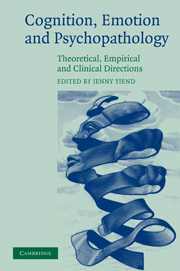Book contents
- Frontmatter
- Contents
- List of contributors
- An introduction and synthesis
- Andrew Mathews: a brief history of a clinical scientist
- Part I Theoretical approaches
- Part II Empirical directions
- 5 Habits of thought produce memory biases in anxiety and depression
- 6 Anxiety and the resolution of ambiguity
- 7 Dissociating fear and disgust: implications for the structure of emotions
- 8 The causal status of anxiety-linked attentional and interpretive bias
- 9 The experimental modification of processing biases
- Part III Clinical perspectives
- Index
7 - Dissociating fear and disgust: implications for the structure of emotions
Published online by Cambridge University Press: 23 November 2009
- Frontmatter
- Contents
- List of contributors
- An introduction and synthesis
- Andrew Mathews: a brief history of a clinical scientist
- Part I Theoretical approaches
- Part II Empirical directions
- 5 Habits of thought produce memory biases in anxiety and depression
- 6 Anxiety and the resolution of ambiguity
- 7 Dissociating fear and disgust: implications for the structure of emotions
- 8 The causal status of anxiety-linked attentional and interpretive bias
- 9 The experimental modification of processing biases
- Part III Clinical perspectives
- Index
Summary
Introduction
Several authors have suggested that emotion scientists could fruitfully examine the underlying structure, or functional architecture, of human emotion systems using cognitive neuropsychological techniques (Davidson, 1992; Scherer, 1993; Lane et al., 2000). According to Bub (1994), ‘The general methodological problem for neuropsychology is how evidence, in the form of patterns of cognitive deficits, bears on theory, in the form of rival functional architectures’. Analogously, we can ask how evidence, in the form of patterns of emotion deficits, bears on theory, in the form of rival functional architectures of emotion (Mathews & MacLeod, 1994; Scherer & Peper, 2001).
In collecting evidence, neuropsychologists design experiments to elicit dissociations in task performance. Dissocations can be single (task A normal, task B abnormal), or multiple (tasks A, B normal, tasks C, D abnormal). Double dissociations are obtained when task A is normal, task B abnormal in patient P1; task B normal, task A abnormal in patient P2 (Shallice, 1988). Double dissociation evidence is regarded as the most compelling of all. This is because partial lesions allow dissociations to arise from resource artefacts, as one task demands more of some computational resource of a processing component than another (Shallice, 1988). Resource artefacts can be ruled out by double dissociations, and only systems that contain a high degree of functional specialization can produce strong double dissociations (Shallice, 1988). For this argument to hold, two relatively uncontroversial assumptions must be made:
That impaired processing is explicable in terms of the same model as normal processing, except that certain parameters of the model are changed (i.e. processes are not fundamentally reorganized following damage), and
[…]
- Type
- Chapter
- Information
- Cognition, Emotion and PsychopathologyTheoretical, Empirical and Clinical Directions, pp. 149 - 171Publisher: Cambridge University PressPrint publication year: 2004
- 2
- Cited by



